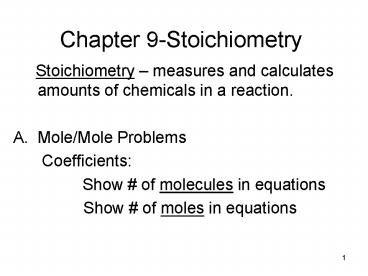Chapter 9-Stoichiometry - PowerPoint PPT Presentation
1 / 13
Title:
Chapter 9-Stoichiometry
Description:
Chapter 9-Stoichiometry Stoichiometry measures and calculates amounts of chemicals in a reaction. Mole/Mole Problems Coefficients: Show # of molecules in equations – PowerPoint PPT presentation
Number of Views:179
Avg rating:3.0/5.0
Title: Chapter 9-Stoichiometry
1
Chapter 9-Stoichiometry
- Stoichiometry measures and calculates
amounts of chemicals in a reaction. - Mole/Mole Problems
- Coefficients
- Show of molecules in equations
- Show of moles in equations
2
Example
- Glucose reacts with oxygen to produce carbon
dioxide and water vapor in cellular respiration. - a. Write a balanced equation for this reaction.
- b.If 0.30 moles of glucose are reacted, how
many moles of carbon dioxide will be produced?
3
- c. If 0.15 moles of glucose are reacted, how
- many moles of oxygen are reacted?
- d. If 0.26 moles of water are produced, how
- many moles of glucose are reacted?
4
- B. Mass Stoichiometry Problems
- First-Write a Balanced Equation
- 1. Change to Moles
- 2. Use Coefficients (Mole Ratios)
- changes chemical
- 3. Change to what is asked for
- May not need steps 1 or 3 depends on what you
are given and what is asked for.
5
- Examples
- 1. Hydrogen peroxide (H2O2) decomposes to form
water and oxygen gas. If 25.0 grams of hydrogen
peroxide decompose, how many grams of oxygen will
be produced?
6
- 2. 55.0 grams of hydrogen fluoride are completely
reacted with tin. How many moles of tin (II)
fluoride are produced?
7
- C. Limiting Excess Reactants
- Reactants are not always completely used up in a
reaction. - Excess Reactant reactant that has leftovers at
the end of the reaction. - Limiting Reactant reactant that is completely
used up in the reaction - makes the least product
8
- Example
- 2.25 grams of PCl3 are mixed with
- 1.23 grams of H2O in the following reaction
- PCl3 3H2O ? H3PO3 3HCl
- Calculate the limiting excess reactants
9
- b. How many grams of HCl will be produced?
- c. How many grams of the excess reactant
- will be left?
10
- D. Percent Yield
- Grams of Product calculated from limiting
reactant Theoretical Yield - This is amount of product that should be
produced if experiment is 100 perfect. - Amount really produced Actual Yield
- Yield Actual Yield x 100
- Theoretical Yield
11
- Example
- When 14.0 grams of nitrogen gas are mixed
- with 9.0 grams of hydrogen gas,
- 16.1 grams of ammonia gas are formed.
- 1. Write a balanced equation for this reaction.
12
- 2. Calculate to find the limiting excess
- reactants.
- 3. What is the theoretical yield in grams of
- ammonia?
13
- 4. What is the percent yield of ammonia in this
reaction? - 5. How many grams of the excess reactant
- are left?

